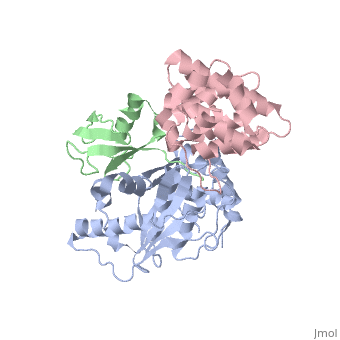2iy0
From Proteopedia
SENP1 (mutant) SUMO1 RanGAP
Structural highlights
FunctionSENP1_HUMAN Protease that catalyzes two essential functions in the SUMO pathway: processing of full-length SUMO1, SUMO2 and SUMO3 to their mature forms and deconjugation of SUMO1, SUMO2 and SUMO3 from targeted proteins. Deconjugates SUMO1 from HIPK2. Deconjugates SUMO1 from HDAC1, which decreases its transcriptional repression activity.[1] [2] [3] [4] Evolutionary ConservationCheck, as determined by ConSurfDB. You may read the explanation of the method and the full data available from ConSurf. Publication Abstract from PubMedSmall ubiquitin-like modifier (SUMO)-specific protease SENP1 processes SUMO-1, SUMO-2 and SUMO-3 to mature forms and deconjugates them from modified proteins. To establish the proteolytic mechanism, we determined structures of catalytically inactive SENP1 bound to SUMO-1-modified RanGAP1 and to unprocessed SUMO-1. In each case, the scissile peptide bond is kinked at a right angle to the C-terminal tail of SUMO-1 and has the cis configuration of the amide nitrogens. SENP1 preferentially processes SUMO-1 over SUMO-2, but binding thermodynamics of full-length SUMO-1 and SUMO-2 to SENP1 and K(m) values for processing are very similar. However, k(cat) values differ by 50-fold. Thus, discrimination between unprocessed SUMO-1 and SUMO-2 by SENP1 is based on a catalytic step rather than substrate binding and is likely to reflect differences in the ability of SENP1 to correctly orientate the scissile bonds in SUMO-1 and SUMO-2. SUMO protease SENP1 induces isomerization of the scissile peptide bond.,Shen L, Tatham MH, Dong C, Zagorska A, Naismith JH, Hay RT Nat Struct Mol Biol. 2006 Dec;13(12):1069-77. Epub 2006 Nov 12. PMID:17099698[5] From MEDLINE®/PubMed®, a database of the U.S. National Library of Medicine. See AlsoReferences
| ||||||||||||||||||


